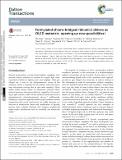Formylated chloro-bridged iridium(III) dimers as OLED materials : opening up new possibilities
Abstract
In this study, a series of four formyl-substituted chloro-bridged iridium(III) dimers were prepared. Their absorption, photophysical and electrochemical properties were studied in dichloromethane solution. It was found that as the formyl content increased on the cyclometalating ligands, emission unexpectedly became brighter. Organic light-emitting diodes (OLEDs) were fabricated using each of these iridium dimers as the emitter. The OLED fabricated using the brightest of the series, 2b, as the dopant afforded a decent external quantum efficiency (EQE) of 2.6%. This suggests that chloro-bridged iridium dimers are potential candidates as solid-state emitters.
Citation
Wong , M Y , Xie , G , Tourbillon , C , Sandroni , M , Cordes , D B , Slawin , A M Z , Samuel , I D W & Zysman-Colman , E 2015 , ' Formylated chloro-bridged iridium(III) dimers as OLED materials : opening up new possibilities ' , Dalton Transactions , vol. 44 , no. 18 . https://doi.org/10.1039/C4DT03127J
Publication
Dalton Transactions
Status
Peer reviewed
ISSN
1477-9226Type
Journal article
Description
Date of Acceptance: 17/10/2014Collections
Items in the St Andrews Research Repository are protected by copyright, with all rights reserved, unless otherwise indicated.

